Polyurethanes Modified by Ionic Liquids and Their Applications
Abstract
1. Introduction
2. Fabrication Methods of Ionic Liquid-Modified PU (PU-IL)
2.1. Physical Blending of ILs with PU by Solvent Casting
2.2. Copolymerization of ILs with Monomers or Prepolymers for PU
3. Applications of PU-IL
3.1. Sensors
3.2. Actuators
3.3. Transistors
3.4. Antistatic Films
3.5. Solid-State Polymer Electrolytes
3.6. Flame-Retardant Elastomers
3.7. Carbon Dioxide Capture
3.8. Biomedical Applications
4. Conclusions
Author Contributions
Funding
Institutional Review Board Statement
Informed Consent Statement
Data Availability Statement
Conflicts of Interest
References
- Zeng, H.; Fu, S.; Liang, Y.; Liu, L. Effect of branched structure on microphase separation and electric field induced bending actuation behaviors of poly(urethane–urea) elastomers. Smart Mater. Struct. 2022, 32, 015017. [Google Scholar] [CrossRef]
- Xu, W.; Zhang, R.; Liu, W.; Zhu, J.; Dong, X.; Guo, H.; Hu, G.-H. A Multiscale Investigation on the Mechanism of Shape Recovery for IPDI to PPDI Hard Segment Substitution in Polyurethane. Macromolecules 2016, 49, 5931–5944. [Google Scholar] [CrossRef]
- Huang, G.; Yang, T.; He, Z.; Yu, L.; Xiao, H. Polyurethane as a modifier for road asphalt: A literature review. Constr. Build. Mate. 2022, 356, 129058. [Google Scholar] [CrossRef]
- Jing, G.; Qie, L.; Markine, V.; Jia, W. Polyurethane reinforced ballasted track: Review, innovation and challenge. Constr. Build. Mate. 2019, 208, 734–748. [Google Scholar] [CrossRef]
- Chen, T.; Xie, Y.; Wang, Z.; Lou, J.; Liu, D.; Xu, R.; Cui, Z.; Li, S.; Panahi-Sarmad, M.; Xiao, X. Recent Advances of Flexible Strain Sensors Based on Conductive Fillers and Thermoplastic Polyurethane Matrixes. ACS Appl. Polym. Mater. 2021, 3, 5317–5338. [Google Scholar] [CrossRef]
- Liu, S.; Duan, R.; He, S.; Liu, H.; Huang, M.; Liu, X.; Liu, W.; Zhu, C. Research progress on dielectric properties of PU and its application on capacitive sensors and OTFTs. React. Funct. Polym. 2022, 181, 105420. [Google Scholar] [CrossRef]
- Gunatillake, P.A.; Dandeniyage, L.S.; Adhikari, R.; Bown, M.; Shanks, R.; Adhikari, B. Advancements in the Development of Biostable Polyurethanes. Polym. Rev. 2018, 59, 391–417. [Google Scholar] [CrossRef]
- Wang, J.; Dai, D.; Xie, H.; Li, D.; Xiong, G.; Zhang, C. Biological Effects, Applications and Design Strategies of Medical Polyurethanes Modified by Nanomaterials. Int. J. Nanomed. 2022, 17, 6791–6819. [Google Scholar] [CrossRef]
- He, Y.; Xie, D.; Zhang, X. The structure, microphase-separated morphology, and property of polyurethanes and polyureas. J. Mater. Sci. 2014, 49, 7339–7352. [Google Scholar] [CrossRef]
- Reghunadhan, A.; Thomas, S. Chapter 1—Polyurethanes: Structure, Properties, Synthesis, Characterization, and Applications. In Polyurethane Polymers; Thomas, S., Datta, J., Haponiuk, J.T., Reghunadhan, A., Eds.; Elsevier: Amsterdam, The Netherlands, 2017; pp. 1–16. [Google Scholar]
- Xie, F.; Zhang, T.; Bryant, P.; Kurusingal, V.; Colwell, J.M.; Laycock, B. Degradation and stabilization of polyurethane elastomers. Prog. Polym. Sci. 2019, 90, 211–268. [Google Scholar] [CrossRef]
- Datta, J.; Kasprzyk, P. Thermoplastic polyurethanes derived from petrochemical or renewable resources: A comprehensive review. Polym. Eng. Sci. 2018, 58, E14–E35. [Google Scholar] [CrossRef]
- Krol, P. Synthesis methods, chemical structures and phase structures of linear polyurethanes. Properties and applications of linear polyurethanes in polyurethane elastomers, copolymers and ionomers. Prog. Mater. Sci. 2007, 52, 915–1015. [Google Scholar] [CrossRef]
- de Souza, F.M.; Kahol, P.K.; Gupta, R.K. Introduction to Polyurethane Chemistry. In Polyurethane Chemistry: Renewable Polyols and Isocyanates, 1st ed.; Gupta, R.K., Kahol, P.K., Eds.; American Chemical Society: Washington, DC, USA, 2021; Volume 1380, pp. 1–24. [Google Scholar]
- Maiuolo, L.; Olivito, F.; Ponte, F.; Algieri, V.; Tallarida, M.A.; Tursi, A.; Chidichimo, G.; Sicilia, E.; De Nino, A. A novel catalytic two-step process for the preparation of rigid polyurethane foams: Synthesis, mechanism and computational studies. React. Chem. Eng. 2021, 6, 1238–1245. [Google Scholar] [CrossRef]
- Zhong, Q.; Chen, X.; Yang, Y.; Cui, C.; Ma, L.; Li, Z.; Zhang, Q.; Chen, X.; Cheng, Y.; Zhang, Y. Hydrogen bond reinforced, transparent polycaprolactone-based degradable polyurethane. Mater. Chem. Front. 2021, 5, 5371–5381. [Google Scholar] [CrossRef]
- Yu, S.; Zhang, R.; Wu, Q.; Chen, T.; Sun, P. Bio-inspired high-performance and recyclable cross-linked polymers. Adv. Mater. 2013, 25, 4912–4917. [Google Scholar] [CrossRef]
- Xiao, S.; Sue, H.-J. Effect of molecular weight on scratch and abrasive wear behaviors of thermoplastic polyurethane elastomers. Polymer 2019, 169, 124–130. [Google Scholar] [CrossRef]
- Cheng, B.-X.; Gao, W.-C.; Ren, X.-M.; Ouyang, X.-Y.; Zhao, Y.; Zhao, H.; Wu, W.; Huang, C.-X.; Liu, Y.; Liu, X.-Y.; et al. A review of microphase separation of polyurethane: Characterization and applications. Polym. Test. 2022, 107, 107489. [Google Scholar] [CrossRef]
- Niemczyk, A.; Piegat, A.; Sonseca Olalla, Á.; El Fray, M. New approach to evaluate microphase separation in segmented polyurethanes containing carbonate macrodiol. Eur. Polym. J. 2017, 93, 182–191. [Google Scholar] [CrossRef]
- Saralegi, A.; Rueda, L.; Fernández-d’Arlas, B.; Mondragon, I.; Eceiza, A.; Corcuera, M.A. Thermoplastic polyurethanes from renewable resources: Effect of soft segment chemical structure and molecular weight on morphology and final properties. Polym. Int. 2013, 62, 106–115. [Google Scholar] [CrossRef]
- Zhang, Q.; Lin, X.; Chen, W.; Jiang, K.; Han, D. Applications of characterization methods in polyurethane materials: Analysis of microphase-separated structures. App. Spectrosc. Rev. 2021, 57, 153–176. [Google Scholar] [CrossRef]
- Liang, Y.; Cui, T.; Liu, L. Effect of multi-armed chain extender on microphase morphology, stress-strain behavior and electromechanical properties of polyurethane elastomers. Polymer 2021, 235, 124279. [Google Scholar] [CrossRef]
- Xiang, D.; He, J.; Cui, T.; Liu, L.; Shi, Q.S.; Ma, L.C.; Liang, Y. Multiphase Structure and Electromechanical Behaviors of Aliphatic Polyurethane Elastomers. Macromolecules 2018, 51, 6369–6379. [Google Scholar] [CrossRef]
- Pringpromsuk, S.; Xia, H.; Ni, Q.-Q. Multifunctional stimuli-responsive shape memory polyurethane gels for soft actuators. Sens. Actuat. A-Phys. 2020, 313, 112207. [Google Scholar] [CrossRef]
- Gao, Y.; Lv, J.; Liu, L.; Yu, Y. Effect of diacylhydrazine as chain extender on microphase separation and performance of energetic polyurethane elastomer. e-Polymers 2020, 20, 469–481. [Google Scholar] [CrossRef]
- Wang, H.; Xu, J.; Li, K.; Dong, Y.; Du, Z.; Wang, S. Highly stretchable, self-healable, and self-adhesive ionogels with efficient antibacterial performances for a highly sensitive wearable strain sensor. J. Mater. Chem. B 2022, 10, 1301–1307. [Google Scholar] [CrossRef]
- Renard, C.; Wang, D.; Yang, Y.; Xiong, S.; Shi, C.-Y.; Dang, Z.-M. Plasticized thermoplastic polyurethanes for dielectric elastomers with improved electromechanical actuation. J. Appl. Polym. Sci. 2017, 134, 45123. [Google Scholar] [CrossRef]
- Li, C.; Xia, H.; Ni, Q.Q. Actuation Characteristics and Mechanism of Electroactive Plasticized Thermoplastic Polyurethane. Langmuir 2020, 36, 14933–14941. [Google Scholar] [CrossRef]
- Li, C.; Xia, H.; Yao, J.; Ni, Q.-Q. Electrically induced soft actuators based on thermoplastic polyurethane and their actuation performances including tiny force measurement. Polymer 2019, 180, 121678. [Google Scholar] [CrossRef]
- Tian, M.; Yao, Y.; Liu, S.; Yang, D.; Zhang, L.; Nishi, T.; Ning, N. Separated-structured all-organic dielectric elastomer with large actuation strain under ultra-low voltage and high mechanical strength. J. Mater. Chem. A 2015, 3, 1483–1491. [Google Scholar] [CrossRef]
- Tian, M.; Yan, B.; Yao, Y.; Zhang, L.; Nishi, T.; Ning, N. Largely improved actuation strain at low electric field of dielectric elastomer by combining disrupting hydrogen bonds with ionic conductivity. J. Mater. Chem. C 2014, 2, 8388–8397. [Google Scholar] [CrossRef]
- Wang, K.; Zhou, Z.; Zhang, J.; Tang, J.; Wu, P.; Wang, Y.; Zhao, Y.; Leng, Y. Electrical and Thermal and Self-Healing Properties of Graphene-Thermopolyurethane Flexible Conductive Films. Nanomaterials 2020, 10, 753. [Google Scholar] [CrossRef]
- Lee, C.-F.; Chen, C.-W.; Chuang, F.-S.; Rwei, S.-P. Thermoplastic polyurethane/CNT nanocomposites with low electromagnetic resistance property. J. Compos. Mater. 2021, 55, 4321–4331. [Google Scholar] [CrossRef]
- Li, H.; Chen, J.; Chang, X.; Xu, Y.; Zhao, G.; Zhu, Y.; Li, Y. A highly stretchable strain sensor with both an ultralow detection limit and an ultrawide sensing range. J. Mater. Chem. A 2021, 9, 1795–1802. [Google Scholar] [CrossRef]
- Jiang, N.; Chang, X.; Hu, D.; Chen, L.; Wang, Y.; Chen, J.; Zhu, Y. Flexible, transparent, and antibacterial ionogels toward highly sensitive strain and temperature sensors. Chem. Eng. J. 2021, 424, 130418. [Google Scholar] [CrossRef]
- Jiao, C.; Wang, H.; Chen, X.; Tang, G. Flame retardant and thermal degradation properties of flame retardant thermoplastic polyurethane based on HGM@[EOOEMIm][BF4]. J. Therm. Anal. Calorim. 2018, 135, 3141–3152. [Google Scholar] [CrossRef]
- Putson, C.; Jaaoh, D.; Muensit, N. Large electromechanical strain at low electric field of modified polyurethane composites for flexible actuators. Mater. Lett. 2016, 172, 27–31. [Google Scholar] [CrossRef]
- Fang, Y.; Xu, J.; Gao, F.; Du, X.; Du, Z.; Cheng, X.; Wang, H. Self-healable and recyclable polyurethane-polyaniline hydrogel toward flexible strain sensor. Compos. Part. B-Eng. 2021, 219, 108965. [Google Scholar] [CrossRef]
- Aguilar Bolados, H.; Hernández-Santana, M.; Romasanta, L.J.; Yazdani-Pedram, M.; Quijada, R.; López-Manchado, M.A.; Verdejo, R. Electro-mechanical actuation performance of SEBS/PU blends. Polymer 2019, 171, 25–33. [Google Scholar] [CrossRef]
- Nordness, O.; Brennecke, J.F. Ion Dissociation in Ionic Liquids and Ionic Liquid Solutions. Chem. Rev. 2020, 120, 12873–12902. [Google Scholar] [CrossRef]
- Sen, S.; Goodwin, S.E.; Barbará, P.V.; Rance, G.A.; Wales, D.; Cameron, J.M.; Sans, V.; Mamlouk, M.; Scott, K.; Walsh, D.A. Gel–Polymer Electrolytes Based on Poly(Ionic Liquid)/Ionic Liquid Networks. ACS Appl. Polym. Mater. 2020, 3, 200–208. [Google Scholar] [CrossRef]
- Cowan, M.G.; Lopez, A.M.; Masuda, M.; Kohno, Y.; McDanel, W.M.; Noble, R.D.; Gin, D.L. Imidazolium-Based Poly(ionic liquid)/Ionic Liquid Ion-Gels with High Ionic Conductivity Prepared from a Curable Poly(ionic liquid). Macromol. Rapid. Commun. 2016, 37, 1150–1154. [Google Scholar] [CrossRef]
- Gao, M.R.; Yuan, J.; Antonietti, M. Ionic Liquids and Poly(ionic liquid)s for Morphosynthesis of Inorganic Materials. Chemistry 2017, 23, 5391–5403. [Google Scholar] [CrossRef]
- Yoshida, Y.; Kitagawa, H. Ionic Conduction in Metal–Organic Frameworks with Incorporated Ionic Liquids. ACS Sustain. Chem. Eng. 2018, 7, 70–81. [Google Scholar] [CrossRef]
- Lavall, R.L.; Ferrari, S.; Tomasi, C.; Marzantowicz, M.; Quartarone, E.; Magistris, A.; Mustarelli, P.; Lazzaroni, S.; Fagnoni, M. Novel polymer electrolytes based on thermoplastic polyurethane and ionic liquid/lithium bis(trifluoromethanesulfonyl)imide/propylene carbonate salt system. J. Power Sources 2010, 195, 5761–5767. [Google Scholar] [CrossRef]
- Yamada, S.; Toshiyoshi, H. Temperature Sensor with a Water-Dissolvable Ionic Gel for Ionic Skin. ACS Appl. Mater. Interfaces 2020, 12, 36449–36457. [Google Scholar] [CrossRef]
- Ali, I.; Latif, A.; Hussain, K.; Shehzad, F.K.; Ali, A.; Faisal, R.; Xudong, L.; Dias, O.A.T.; Weimin, Y.; Haoyi, L. Ionic liquids enhanced performance of PVC gels actuator. J. Appl. Polym. Sci. 2021, 138, 50710. [Google Scholar] [CrossRef]
- Zampino, D.; Mancuso, M.; Zaccone, R.; Ferreri, T.; Borzacchiello, A.; Zeppetelli, S.; Dattilo, S.; Ussia, M.; Ferreri, L.; Carbone, D.C.; et al. Thermo-mechanical, antimicrobial and biocompatible properties of PVC blends based on imidazolium ionic liquids. Mat. Sci. Eng. C 2021, 122, 111920. [Google Scholar] [CrossRef]
- Prasad, B.; Gill, F.S.; Panwar, V.; Anoop, G. Development of strain sensor using conductive poly(vinylidene fluoride) (PVDF) nanocomposite membrane reinforced with ionic liquid (IL) & carbon nanofiber (CNF). Compos. Part. B Eng. 2019, 173, 106990. [Google Scholar]
- Xu, P.; Fu, W.; Hu, Y.; Ding, Y. Effect of annealing treatment on crystalline and dielectric properties of PVDF/PEG-containing ionic liquid composites. Compos. Sci. Technol. 2018, 158, 1–8. [Google Scholar] [CrossRef]
- Zhou, H.; Wang, H.; Liu, Z.; Yang, H.; Yuan, C.; Wang, Y. Facilitated phase transformation of PVDF in its composite with an ionic liquid. Polymer 2021, 220, 123564. [Google Scholar] [CrossRef]
- Aidoud, D.; Etiemble, A.; Guy-Bouyssou, D.; Maire, E.; Le Bideau, J.; Guyomard, D.; Lestriez, B. Interfacial stability and electrochemical behavior of Li/LiFePO4 batteries using novel soft and weakly adhesive photo-ionogel electrolytes. J. Power. Sources 2016, 330, 92–103. [Google Scholar] [CrossRef]
- Pourjavadi, A.; Doulabi, M.; Hosseini, S.H. Novel polyelectrolyte gels as absorbent polymers for nonpolar organic solvents based on polymerizable ionic liquids. Polymer 2012, 53, 5737–5742. [Google Scholar] [CrossRef]
- Magurudeniya, H.D.; Ringstrand, B.S.; Seifert, S.; Firestone, M.A. Reversible hierarchical structure induced by solvation and temperature modulation in an ionic liquid-based random bottlebrush copolymer. Polym. Chem. 2018, 9, 5200–5214. [Google Scholar] [CrossRef]
- He, B.; Peng, H.; Chen, Y.; Zhao, Q. High performance polyamide nanofiltration membranes enabled by surface modification of imidazolium ionic liquid. J. Membr. Sci. 2020, 608, 118202. [Google Scholar] [CrossRef]
- Li, N.-B.; Wang, M.; Guo, L.-X.; Lin, B.-P.; Yang, H. Ionic liquid embedded polyimides with ultra-foldability, ultra-flexibility, ultra-processability and superior optical transparency. Polymer 2018, 153, 538–547. [Google Scholar] [CrossRef]
- Kerscher, B.; Trötschler, T.M.; Pásztói, B.; Gröer, S.; Szabó, Á.; Iván, B.; Mülhaupt, R. Thermoresponsive Polymer Ionic Liquids and Nanostructured Hydrogels Based upon Amphiphilic Polyisobutylene-b-poly(2-ethyl-2-oxazoline) Diblock Copolymers. Macromolecules 2019, 52, 3306–3318. [Google Scholar] [CrossRef]
- Shamsuri, A.A.; Jamil, S.N.A.M.; Abdan, K. Processes and Properties of Ionic Liquid-Modified Nanofiller/Polymer Nanocomposites—A Succinct Review. Processes 2021, 9, 480. [Google Scholar] [CrossRef]
- Kosiński, S.; Rykowska, I.; Gonsior, M.; Krzyżanowski, P. Ionic liquids as antistatic additives for polymer composites—A review. Polym. Test. 2022, 112, 107649. [Google Scholar] [CrossRef]
- Shen, Y.; Xu, G.; Li, J.; Lin, X.; Yang, F.; Yang, H.; Chen, W.; Wu, Y.; Wu, X.; Cheng, Q.; et al. Functional Ionic Liquid Polymer Stabilizer for High-Performance Perovskite Photovoltaics. Angew. Chem. Int. Ed. 2023, 62, e202300690. [Google Scholar] [CrossRef]
- Stumphauser, T.; Kasza, G.; Domján, A.; Wacha, A.; Varga, Z.; Thomann, Y.; Thomann, R.; Pásztói, B.; Trötschler, T.M.; Kerscher, B.; et al. Nanoconfined Crosslinked Poly(ionic liquid)s with Unprecedented Selective Swelling Properties Obtained by Alkylation in Nanophase-Separated Poly(1-vinylimidazole)-l-poly(tetrahydrofuran) Conetworks. Polymers 2020, 12, 2292. [Google Scholar] [CrossRef]
- Yang, Y.; Guo, Y.; Gao, C.; North, M.; Yuan, J.; Xie, H.; Zheng, Q. Fabrication of Carboxylic Acid and Imidazolium Ionic Liquid Functionalized Porous Cellulosic Materials for the Efficient Conversion of Carbon Dioxide into Cyclic Carbonates. ACS Sustain. Chem. Eng. 2023, 11, 2634–2646. [Google Scholar] [CrossRef]
- Liu, Z.; Li, B.; Liu, Y.D.; Liang, Y. Integrated Bending Actuation and the Self-Sensing Capability of Poly(Vinyl Chloride) Gels with Ionic Liquids. Adv. Funct. Mater. 2022, 32, 2204259. [Google Scholar] [CrossRef]
- Li, B.; Liu, Z.; Liu, Y.D.; Liang, Y. Synergistic and counteractive effects of Bi-component plasticizers on structure and electric field-induced bending actuation behaviors of poly (vinyl chloride) (PVC) gels. Polymer 2022, 256, 125201. [Google Scholar] [CrossRef]
- Lan, J.; Li, Y.; Yan, B.; Yin, C.; Ran, R.; Shi, L.Y. Transparent Stretchable Dual-Network Ionogel with Temperature Tolerance for High-Performance Flexible Strain Sensors. ACS Appl. Mater. Interfaces 2020, 12, 37597–37606. [Google Scholar] [CrossRef]
- Mori, D.I.; Martin, R.M.; Noble, R.D.; Gin, D.L. Cross-linked, polyurethane-based, ammonium poly(ionic liquid)/ionic liquid composite films for organic vapor suppression and ion conduction. Polymer 2017, 112, 435–446. [Google Scholar] [CrossRef]
- Wu, B.; Hu, Z.; Zhang, Y.; Xiao, Y.; Lei, J.; Zhou, C. Synthesis and characterization of permanently antistatic polyurethanes containing ionic liquids. Polym. Eng. Sci. 2016, 56, 629–635. [Google Scholar] [CrossRef]
- Wei, H.; Zhu, Z.; Sun, H.; Mu, P.; Liang, W.; Li, A. Graphene and poly(ionic liquid) modified polyurethane sponges with enhanced flame-retardant properties. J. App. Polym. Sci. 2017, 134, 45477. [Google Scholar] [CrossRef]
- Xing, C.; Guan, J.; Chen, Z.; Zhu, Y.; Zhang, B.; Li, Y.; Li, J. Novel multifunctional nanofibers based on thermoplastic polyurethane and ionic liquid: Towards antibacterial, anti-electrostatic and hydrophilic nonwovens by electrospinning. Nanotechnology 2015, 26, 105704. [Google Scholar] [CrossRef]
- Li, D.; Yuan, L.; Liang, G.; Gu, A. Self-Healable and Remoldable Transparent Polyurethane Film with High Dielectric Constant from the Synergistic Effect between Lithium Salt and Ionic Liquid. Ind. Eng. Chem. Res. 2020, 59, 6600–6608. [Google Scholar] [CrossRef]
- Chen, J.; Wang, F.; Zhu, G.; Wang, C.; Cui, X.; Xi, M.; Chang, X.; Zhu, Y. Breathable Strain/Temperature Sensor Based on Fibrous Networks of Ionogels Capable of Monitoring Human Motion, Respiration, and Proximity. ACS Appl. Mater. Interfaces 2021, 13, 51567–51577. [Google Scholar] [CrossRef]
- Jin, M.L.; Park, S.; Kim, J.S.; Kwon, S.H.; Zhang, S.; Yoo, M.S.; Jang, S.; Koh, H.J.; Cho, S.Y.; Kim, S.Y.; et al. An Ultrastable Ionic Chemiresistor Skin with an Intrinsically Stretchable Polymer Electrolyte. Adv. Mater. 2018, 30, e1706851. [Google Scholar] [CrossRef]
- Okuzaki, H.; Takagi, S.; Hishiki, F.; Tanigawa, R. Ionic liquid/polyurethane/PEDOT:PSS composites for electro-active polymer actuators. Sensor. Actuat. B-Chem. 2014, 194, 59–63. [Google Scholar] [CrossRef]
- Zhang, M.; Xia, X.; Zhang, L.; Zhao, G.; Liu, C.; Li, N.; Xu, J.; Chen, Y.; Jian, X. Design of healable, porous polyurethane with large ionic liquids loading amounts towards ultra-durable pressure sensor. Eur. Polym. J. 2023, 191, 112018. [Google Scholar] [CrossRef]
- Liu, X.; Zhan, Y.; Zhao, C.; Su, Y.; Ge, Z.; Luo, Y. A Novel Polymer Electrolyte Matrix Incorporating Ionic Liquid into Waterborne Polyurethane for Lithium-Ion Battery. Polymers 2020, 12, 1513. [Google Scholar] [CrossRef]
- Imaizumi, S.; Kato, Y.; Kokubo, H.; Watanabe, M. Driving mechanisms of ionic polymer actuators having electric double layer capacitor structures. J. Phys. Chem. B 2012, 116, 5080–5089. [Google Scholar] [CrossRef]
- Xu, Y.; Chen, L.; Chen, J.; Chang, X.; Zhu, Y. Flexible and Transparent Pressure/Temperature Sensors Based on Ionogels with Bioinspired Interlocked Microstructures. ACS Appl. Mater. Interfaces 2022, 14, 2122–2131. [Google Scholar] [CrossRef]
- Lee, H.Y.; Cai, Y.; Velioglu, S.; Mu, C.; Chang, C.J.; Chen, Y.L.; Song, Y.; Chew, J.W.; Hu, X.M. Thermochromic Ionogel: A New Class of Stimuli Responsive Materials with Super Cyclic Stability for Solar Modulation. Chem. Mater. 2017, 29, 6947–6955. [Google Scholar] [CrossRef]
- Zhou, R.; Jin, Y.; Zeng, W.; Jin, H.; Bai, L.; Shi, L.; Shang, X. Liquid-Free Ion-Conducting Elastomer with Environmental Stability for Soft Sensing and Thermoelectric Generating. ACS Appl. Mater. Interfaces 2022, 14, 39120–39131. [Google Scholar] [CrossRef]
- Li, T.; Wang, Y.; Li, S.; Liu, X.; Sun, J. Mechanically Robust, Elastic, and Healable Ionogels for Highly Sensitive Ultra-Durable Ionic Skins. Adv. Mater. 2020, 32, e2002706. [Google Scholar] [CrossRef]
- Song, H.; Yu, X.; Nguyen, D.H.; Zhang, C.; Liu, T. Highly stretchable, self-healable and self-adhesive polyzwitterion ionogels enabled with binary noncovalent interactions. Compos. Commun. 2022, 34, 101251. [Google Scholar] [CrossRef]
- Xu, J.; Wang, H.; Du, X.; Cheng, X.; Du, Z.; Wang, H. Self-healing, anti-freezing and highly stretchable polyurethane ionogel as ionic skin for wireless strain sensing. Chem. Eng. J. 2021, 426, 130724. [Google Scholar] [CrossRef]
- Xi, T.; Lu, Y.; Ai, X.; Tang, L.; Yao, L.; Hao, W.; Cui, P. Ionic liquid copolymerized polyurethane membranes for pervaporation separation of benzene/cyclohexane mixtures. Polymer 2019, 185, 121948. [Google Scholar] [CrossRef]
- Texter, J.; Kuriakose, N.; Shendre, S.; Lewis, K.; Venkatraman, S.; Gupta, H. Stimuli-responsively porating gels by condensation. Chem. Commun. 2018, 54, 503–506. [Google Scholar] [CrossRef] [PubMed]
- Han, S.; Zhang, R.; Han, L.; Zhao, C.; Yan, X.; Dai, M. An antifatigue and self-healable ionic polyurethane/ionic liquid composite as the channel layer for a low energy cost synaptic transistor. Eur. Polym. J. 2022, 174, 111292. [Google Scholar] [CrossRef]
- Chung, Y.-C.; Nguyen, D.K.; Choi, J.W.; Chun, B.C. Ionic crosslinking of polyurethane copolymers by the grafted pendant groups. Macromol. Res. 2012, 20, 883–886. [Google Scholar] [CrossRef]
- Behera, P.K.; Mondal, P.; Singha, N.K. Polyurethane with an ionic liquid crosslinker: A new class of super shape memory-like polymers. Polym. Chem. 2018, 9, 4205–4217. [Google Scholar] [CrossRef]
- Behera, P.K.; Usha, K.M.; Guchhait, P.K.; Jehnichen, D.; Das, A.; Voit, B.; Singha, N.K. A novel ionomeric polyurethane elastomer based on ionic liquid as crosslinker. RSC Adv. 2016, 6, 99404–99413. [Google Scholar] [CrossRef]
- Yagci, M.B.; Bolca, S.; Heuts, J.P.A.; Ming, W.; de With, G. Antimicrobial polyurethane coatings based on ionic liquid quaternary ammonium compounds. Prog. Org. Coat. 2011, 72, 343–347. [Google Scholar] [CrossRef]
- Chen, J.; Rong, L.; Liu, X.; Liu, J.; Yang, X.; Jiang, X. Enhancement of flame retardancy of solid polymer electrolyte based on phosphorus-containing ionic liquid polyurethane membrane for safe lithium batteries. Polymer 2023, 269, 125759. [Google Scholar] [CrossRef]
- Gao, R.; Zhang, M.; Wang, S.-W.; Moore, R.B.; Colby, R.H.; Long, T.E. Polyurethanes Containing an Imidazolium Diol-Based Ionic-Liquid Chain Extender for Incorporation of Ionic-Liquid Electrolytes. Macromol. Chem. Phys. 2013, 214, 1027–1036. [Google Scholar] [CrossRef]
- Ghadimi, A.; Gharibi, R.; Yeganeh, H.; Sadatnia, B. Ionic liquid tethered PEG-based polyurethane-siloxane membranes for efficient CO(2)/CH(4) separation. Mater. Sci. Eng. C 2019, 102, 524–535. [Google Scholar] [CrossRef]
- Saalah, S.; Abdullah, L.C.; Aung, M.M.; Salleh, M.Z.; Awang Biak, D.R.; Basri, M.; Jusoh, E.R. Waterborne polyurethane dispersions synthesized from jatropha oil. Ind. Crops Prod. 2015, 64, 194–200. [Google Scholar] [CrossRef]
- Chen, C.; Ying, W.B.; Li, J.; Kong, Z.; Li, F.; Hu, H.; Tian, Y.; Kim, D.H.; Zhang, R.; Zhu, J. A Self-Healing and Ionic Liquid Affiliative Polyurethane toward a Piezo 2 Protein Inspired Ionic Skin. Adv. Funct. Mater. 2022, 32, 2106341. [Google Scholar] [CrossRef]
- Hwang, K.K.S.; Yang, C.-Z.; Cooper, S.L. Properties of polyether-polyurethane zwitterionomers. Polym. Eng. Sci. 1981, 21, 1027–1036. [Google Scholar] [CrossRef]
- Jourdain, A.; Antoniuk, I.; Serghei, A.; Espuche, E.; Drockenmuller, E. 1,2,3-Triazolium-based linear ionic polyurethanes. Polym. Chem. 2017, 8, 5148–5156. [Google Scholar] [CrossRef]
- Huang, Z.; Nazifi, S.; Cheng, K.; Karim, A.; Ghasemi, H. Scalable inter-diffused zwitterionic polyurethanes for durable antibacterial coatings. Chem. Eng. J. 2021, 422, 130085. [Google Scholar] [CrossRef]
- Amoli, V.; Kim, J.S.; Jee, E.; Chung, Y.S.; Kim, S.Y.; Koo, J.; Choi, H.; Kim, Y.; Kim, D.H. A bioinspired hydrogen bond-triggered ultrasensitive ionic mechanoreceptor skin. Nat. Commun. 2019, 10, 4019. [Google Scholar] [CrossRef]
- Iwata, T.; Tsurumaki, A.; Tajima, S.; Ohno, H. Fixation of ionic liquids into polyether-based polyurethane films to maintain long-term antistatic properties. Polymer 2014, 55, 2501–2504. [Google Scholar] [CrossRef]
- Chen, X.; Ma, C.; Jiao, C. Synergistic effects between [Emim]PF6 and aluminum hypophosphite on flame retardant thermoplastic polyurethane. RSC Adv. 2016, 6, 67409–67417. [Google Scholar] [CrossRef]
- Fernández Rojas, M.; Pacheco Miranda, L.; Martinez Ramirez, A.; Pradilla Quintero, K.; Bernard, F.; Einloft, S.; Carreño Díaz, L.A. New biocomposites based on castor oil polyurethane foams and ionic liquids for CO2 capture. Fluid Phase Equilibr. 2017, 452, 103–112. [Google Scholar] [CrossRef]
- da Luz, M.; Dias, G.; Zimmer, H.; Bernard, F.L.; do Nascimento, J.F.; Einloft, S. Poly(ionic liquid)s-based polyurethane blends: Effect of polyols structure and ILs counter cations in CO2 sorption performance of PILs physical blends. Polym. Bull. 2021, 79, 6123–6139. [Google Scholar] [CrossRef]
- Poussard, L.; Burel, F.; Couvercelle, J.P.; Merhi, Y.; Tabrizian, M.; Bunel, C. Hemocompatibilty of new ionic polyurethanes: Influence of carboxylic group insertion modes. Biomaterials 2004, 25, 3473–3483. [Google Scholar] [CrossRef] [PubMed]
- Xiu, Z.; Yang, M.; Wu, R.; Lei, C.; Ren, H.-M.; Yu, B.; Gao, S.; Duan, S.; Wu, D.; Xu, F.-J. Scalable anti-infection polyurethane catheters with long-acting and autoclavable properties. Chem. Eng. J. 2023, 451, 138495. [Google Scholar] [CrossRef]
- Smocot, S.; Zhang, Z.; Zhang, L.; Guo, S.; Cao, C. Printed flexible mechanical sensors. Nanoscale 2022, 14, 17134–17156. [Google Scholar] [CrossRef]
- Zhang, J.-w.; Zhang, Y.; Li, Y.-y.; Wang, P. Textile-Based Flexible Pressure Sensors: A Review. Polym. Rev. 2021, 62, 65–94. [Google Scholar] [CrossRef]
- Liu, R.; He, L.; Cao, M.; Sun, Z.; Zhu, R.; Li, Y. Flexible Temperature Sensors. Front. Chem. 2021, 9, 539678. [Google Scholar] [CrossRef]
- Zhang, Y.; Cui, Y. A flexible calligraphy-integrated in situ humidity sensor. Measurement 2019, 147, 106853. [Google Scholar] [CrossRef]
- Xuan, Y.; Lu, Y.; Honda, S.; Arie, T.; Akita, S.; Takei, K. Active-Matrix-Based Flexible Optical Image Sensor. Adv. Mater. Technol. 2021, 6, 2100259. [Google Scholar] [CrossRef]
- Han, S.T.; Peng, H.; Sun, Q.; Venkatesh, S.; Chung, K.S.; Lau, S.C.; Zhou, Y.; Roy, V.A.L. An Overview of the Development of Flexible Sensors. Adv. Mater. 2017, 29, 1700375. [Google Scholar] [CrossRef]
- Huynh, T.P.; Haick, H. Autonomous Flexible Sensors for Health Monitoring. Adv. Mater. 2018, 30, e1802337. [Google Scholar] [CrossRef]
- Peng, M.; Li, X.; Liu, Y.; Chen, J.; Chang, X.; Zhu, Y. Flexible multisensory sensor based on hierarchically porous ionic liquids/thermoplastic polyurethane composites. Appl. Surf. Sci. 2023, 610, 155516. [Google Scholar] [CrossRef]
- Chen, T.; Ye, G.; Wu, H.; Qi, S.; Ma, G.; Zhang, Y.; Zhao, Y.; Zhu, J.; Gu, X.; Liu, N. Highly Conductive and Underwater Stable Ionic Skin for All-Day Epidermal Biopotential Monitoring. Adv. Funct. Mater. 2022, 32, 2202464. [Google Scholar] [CrossRef]
- Qiu, Y.; Zhang, E.; Plamthottam, R.; Pei, Q. Dielectric Elastomer Artificial Muscle: Materials Innovations and Device Explorations. Acc. Chem. Res. 2019, 52, 316–325. [Google Scholar] [CrossRef] [PubMed]
- Ankit; Tiwari, N.; Ho, F.; Krisnadi, F.; Kulkarni, M.R.; Nguyen, L.L.; Koh, S.J.A.; Mathews, N. High-k, Ultrastretchable Self-Enclosed Ionic Liquid-Elastomer Composites for Soft Robotics and Flexible Electronics. ACS Appl. Mater. Interfaces 2020, 12, 37561–37570. [Google Scholar] [CrossRef]
- Gao, Y.Y.; Zhang, Y.L.; Han, B.; Zhu, L.; Dong, B.; Sun, H.B. Gradient Assembly of Polymer Nanospheres and Graphene Oxide Sheets for Dual-Responsive Soft Actuators. ACS Appl. Mater. Interfaces 2019, 11, 37130–37138. [Google Scholar] [CrossRef]
- Zhao, Y.; Wang, W.; He, Z.; Peng, B.; Di, C.-A.; Li, H. High-performance and multifunctional organic field-effect transistors. Chinese Chem. Lett. 2022, 34, 108094. [Google Scholar] [CrossRef]
- Tsai, M.F.; Jiang, J.; Shao, P.W.; Lai, Y.H.; Chen, J.W.; Ho, S.Z.; Chen, Y.C.; Tsai, D.P.; Chu, Y.H. Oxide Heteroepitaxy-Based Flexible Ferroelectric Transistor. ACS Appl. Mater. Interfaces 2019, 11, 25882–25890. [Google Scholar] [CrossRef]
- Lee, C.; Jeong, J.; Kim, H.; Kim, Y. Ionic nanocluster-evolved polymers for low-voltage flexible organic nonvolatile memory transistors. Mater. Horiz. 2019, 6, 1899–1904. [Google Scholar] [CrossRef]
- Yang, H.M.; Kwon, Y.K.; Lee, S.B.; Kim, S.; Hong, K.; Lee, K.H. Physically Cross-Linked Homopolymer Ion Gels for High Performance Electrolyte-Gated Transistors. ACS Appl. Mater. Interfaces 2017, 9, 8813–8818. [Google Scholar] [CrossRef]
- Tabi, G.D.; Kim, J.S.; Nketia-Yawson, B.; Kim, D.H.; Noh, Y.-Y. High-capacitance polyurethane ionogels for low-voltage operated organic transistors and pressure sensors. J. Mater. Chem. C 2020, 8, 17107–17113. [Google Scholar] [CrossRef]
- Tsurumaki, A.; Iwata, T.; Tokuda, M.; Minami, H.; Navarra, M.A.; Ohno, H. Polymerized ionic liquids as durable antistatic agents for polyether-based polyurethanes. Electrochim. Acta 2019, 308, 115–120. [Google Scholar] [CrossRef]
- Li, C.; Wang, B.; Lu, W.; Wang, D.; Li, Z.; Di, Z.; Liang, J. Effect of Co-polyester antistatic agent modified by carbon nanotubes on the properties of polypropylene fibers. J. Univ. Sci. Technol. Beijing Miner. Metall. Mater. 2007, 14, 573–579. [Google Scholar]
- Su, M.; Chen, X.; Zhang, L.; Min, J. Synthesis of Active Graphene with Para-Ester on Cotton Fabrics for Antistatic Properties. Nanomaterials 2020, 10, 1147. [Google Scholar] [CrossRef]
- Tsurumaki, A.; Tajima, S.; Iwata, T.; Scrosati, B.; Ohno, H. Evaluation of ionic liquids as novel antistatic agents for polymethacrylates. Electrochim. Acta 2017, 248, 556–561. [Google Scholar] [CrossRef]
- Pernak, J.; Czepukowicz, A.; Poźniak, R. New Ionic Liquids and Their Antielectrostatic Properties. Ind. Eng. Chem. Res. 2001, 40, 2379–2383. [Google Scholar] [CrossRef]
- Dirican, M.; Yan, C.; Zhu, P.; Zhang, X. Composite solid electrolytes for all-solid-state lithium batteries. Mat. Sci. Eng. R. 2019, 136, 27–46. [Google Scholar] [CrossRef]
- Ye, T.; Li, L.; Zhang, Y. Recent Progress in Solid Electrolytes for Energy Storage Devices. Adv. Funct. Mater. 2020, 30, 2000077. [Google Scholar] [CrossRef]
- Lau, J.; DeBlock, R.H.; Butts, D.M.; Ashby, D.S.; Choi, C.S.; Dunn, B.S. Sulfide Solid Electrolytes for Lithium Battery Applications. Adv. Energy Mater. 2018, 8, 1800933. [Google Scholar] [CrossRef]
- Zhang, Q.; Liu, K.; Ding, F.; Liu, X. Recent advances in solid polymer electrolytes for lithium batteries. Nano. Res. 2017, 10, 4139–4174. [Google Scholar] [CrossRef]
- Melodia, D.; Bhadra, A.; Lee, K.; Kuchel, R.; Kundu, D.; Corrigan, N.; Boyer, C. 3D Printed Solid Polymer Electrolytes with Bicontinuous Nanoscopic Domains for Ionic Liquid Conduction and Energy Storage. Small 2023, 2206639. [Google Scholar] [CrossRef]
- Xi, G.; Xiao, M.; Wang, S.; Han, D.; Li, Y.; Meng, Y. Polymer-Based Solid Electrolytes: Material Selection, Design, and Application. Adv. Funct. Mater. 2020, 31, 2007598. [Google Scholar] [CrossRef]
- Fang, L.; Sun, W.; Hou, W.; Wang, Z.; Sun, K. A high-safety electrolyte based on functionalized ionic liquid and polyurethane for lithium batteries. Electrochim. Acta 2022, 434, 141316. [Google Scholar] [CrossRef]
- Chattopadhyay, D.K.; Webster, D.C. Thermal stability and flame retardancy of polyurethanes. Prog. Polym. Sci. 2009, 34, 1068–1133. [Google Scholar] [CrossRef]
- Hejna, A. Clays as Inhibitors of Polyurethane Foams’ Flammability. Materials 2021, 14, 4826. [Google Scholar] [CrossRef]
- Kim, H.-T.; Kang, J.; Mun, J.; Oh, S.M.; Yim, T.; Kim, Y.G. Pyrrolinium-based Ionic Liquid as a Flame Retardant for Binary Electrolytes of Lithium Ion Batteries. ACS Sustain. Chem. Eng. 2016, 4, 497–505. [Google Scholar] [CrossRef]
- Chen, X.; Feng, X.; Jiao, C. Combustion and thermal degradation properties of flame-retardant TPU based on EMIMPF6. J. Therm. Anal. Calorim. 2017, 129, 851–857. [Google Scholar] [CrossRef]
- Członka, S.; Strąkowska, A.; Strzelec, K.; Kairytė, A.; Kremensas, A. Melamine, silica, and ionic liquid as a novel flame retardant for rigid polyurethane foams with enhanced flame retardancy and mechanical properties. Polym. Test. 2020, 87, 106511. [Google Scholar] [CrossRef]
- Jiao, C.; Zhang, Y.; Li, S.; Chen, X. Flame retardant effect of 1-aminoethyl-3-methylimidazolium hexafluorophosphate in thermoplastic polyurethane elastomer. J. Therm. Anal. Calorim. 2020, 145, 173–184. [Google Scholar] [CrossRef]
- Ochedi, F.O.; Yu, J.; Yu, H.; Liu, Y.; Hussain, A. Carbon dioxide capture using liquid absorption methods: A review. Environ. Chem. Lett. 2020, 19, 77–109. [Google Scholar] [CrossRef]
- Firaha, D.S.; Kirchner, B. Tuning the Carbon Dioxide Absorption in Amino Acid Ionic Liquids. ChemSusChem 2016, 9, 1591–1599. [Google Scholar] [CrossRef]
- Lemus, J.; Da Silva F., F.A.; Palomar, J.; Carvalho, P.J.; Coutinho, J.A.P. Solubility of carbon dioxide in encapsulated ionic liquids. Sep. Purif. Technol. 2018, 196, 41–46. [Google Scholar] [CrossRef]
- Zhou, M.; Khokarale, S.G.; Balsamo, M.; Mikkola, J.-P.; Hedlund, J. Oligoamine ionic liquids supported on mesoporous microspheres for CO2 separation with good sorption kinetics and low cost. J. CO2 Util. 2020, 39, 101186. [Google Scholar] [CrossRef]
- Kaviani, S.; Kolahchyan, S.; Hickenbottom, K.L.; Lopez, A.M.; Nejati, S. Enhanced solubility of carbon dioxide for encapsulated ionic liquids in polymeric materials. Chem. Eng. J. 2018, 354, 753–757. [Google Scholar] [CrossRef]
- Morozova, S.M.; Shaplov, A.S.; Lozinskaya, E.I.; Mecerreyes, D.; Sardon, H.; Zulfiqar, S.; Suárez-García, F.; Vygodskii, Y.S. Ionic Polyurethanes as a New Family of Poly(ionic liquid)s for Efficient CO2 Capture. Macromolecules 2017, 50, 2814–2824. [Google Scholar] [CrossRef]
- Cloutet, E.; Mumtaz, M.; Cramail, H. Synthesis of PEDOT latexes by dispersion polymerization in aqueous media. Mater. Sci. Eng. C 2009, 29, 377–382. [Google Scholar] [CrossRef]
- Meng, Q.; Hu, J.; Liu, B.; Zhu, Y. A low-temperature thermoplastic anti-bacterial medical orthotic material made of shape memory polyurethane ionomer: Influence of ionic group. J. Biomat. Sci.-Polym. E 2009, 20, 199–218. [Google Scholar] [CrossRef]
- Yang, Z.; Wu, G. Synthetic scheme to improve the solid content of biodegradable waterborne polyurethane by changing the association relationships of hydrophilic fragments. RSC Adv. 2020, 10, 28680–28694. [Google Scholar] [CrossRef]
- Wen, T.-C.; Wang, Y.-J.; Cheng, T.-T.; Yang, C.-H. The effect of DMPA units on ionic conductivity of PEG–DMPA–IPDI waterborne polyurethane as single-ion electrolytes. Polymer 1999, 40, 3979–3988. [Google Scholar] [CrossRef]
- Duan, N.; Sun, Z.; Ren, Y.; Liu, Z.; Liu, L.; Yan, F. Imidazolium-based ionic polyurethanes with high toughness, tunable healing efficiency and antibacterial activities. Polym. Chem. 2020, 11, 867–875. [Google Scholar] [CrossRef]
- Wang, C.; Guo, Y.; Chen, J.; Zhu, Y. Transparent and flexible electromagnetic interference shielding film based on Ag nanowires/ionic liquids/thermoplastic polyurethane ternary composites. Compos. Commun. 2023, 37, 101444. [Google Scholar] [CrossRef]

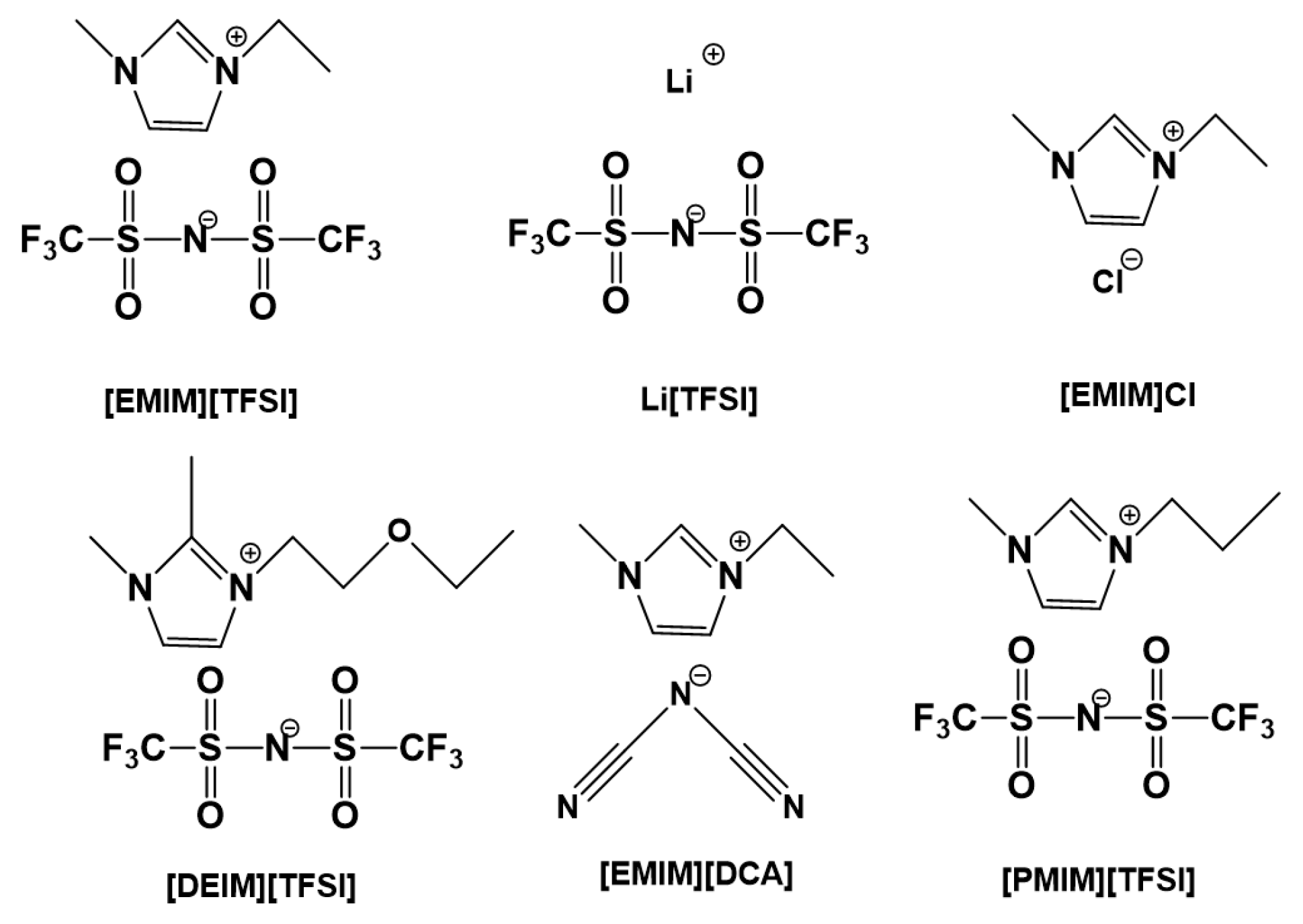
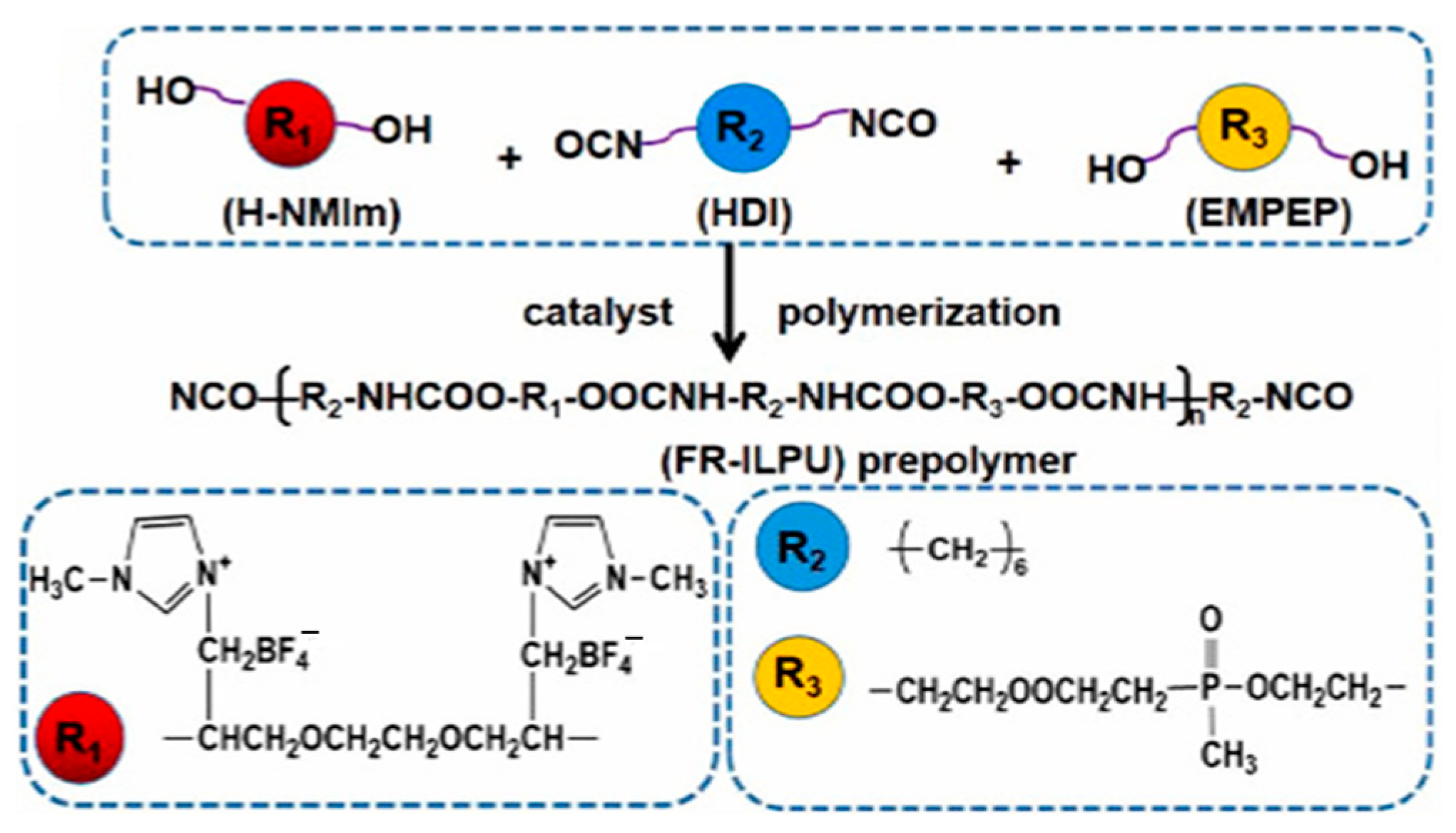

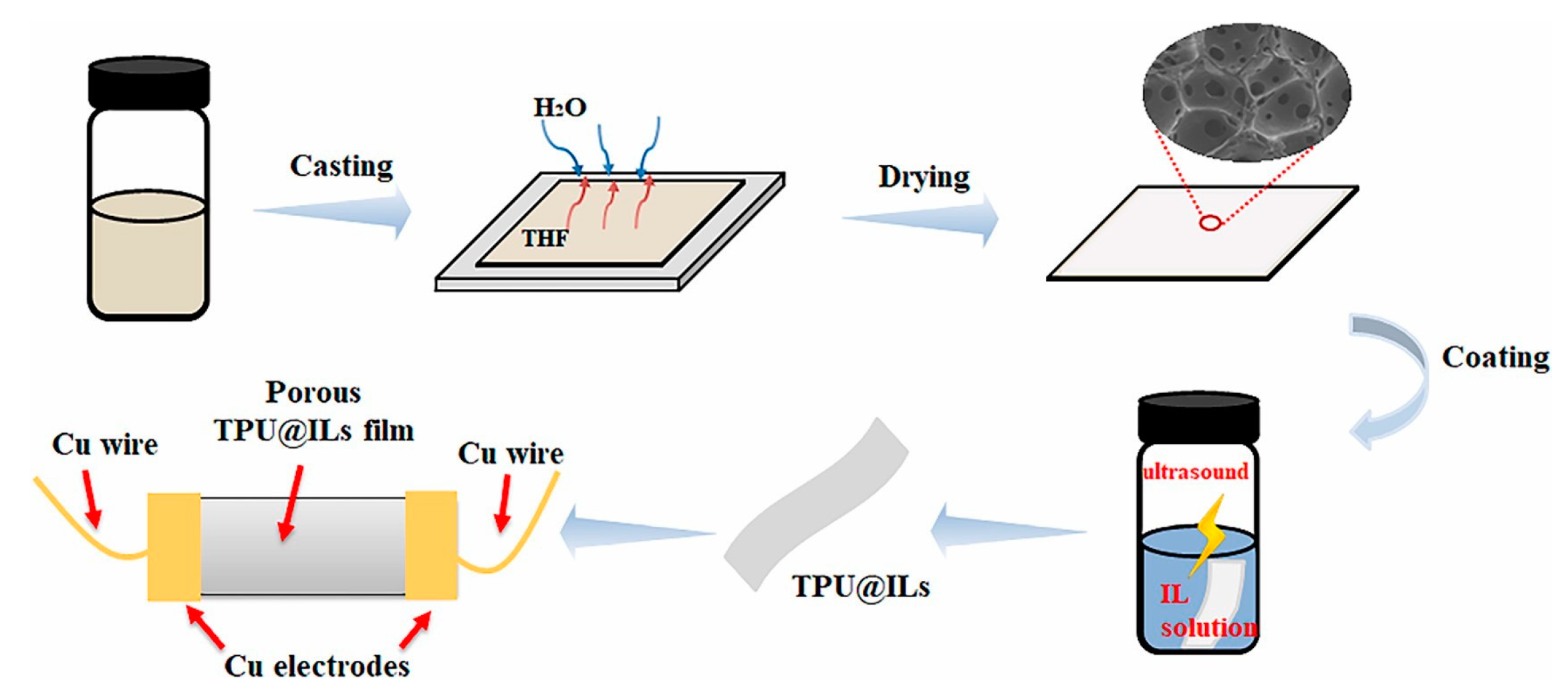
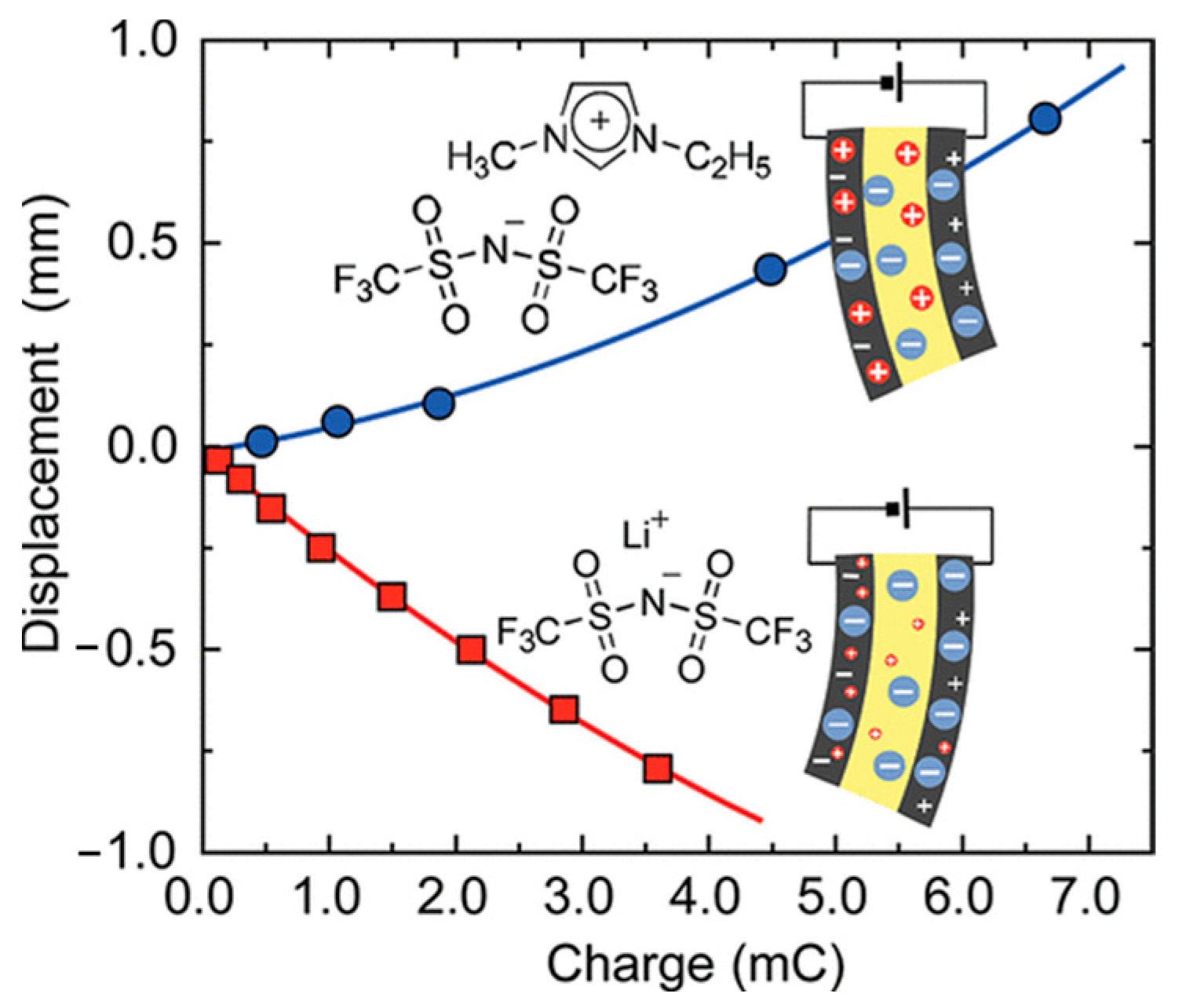

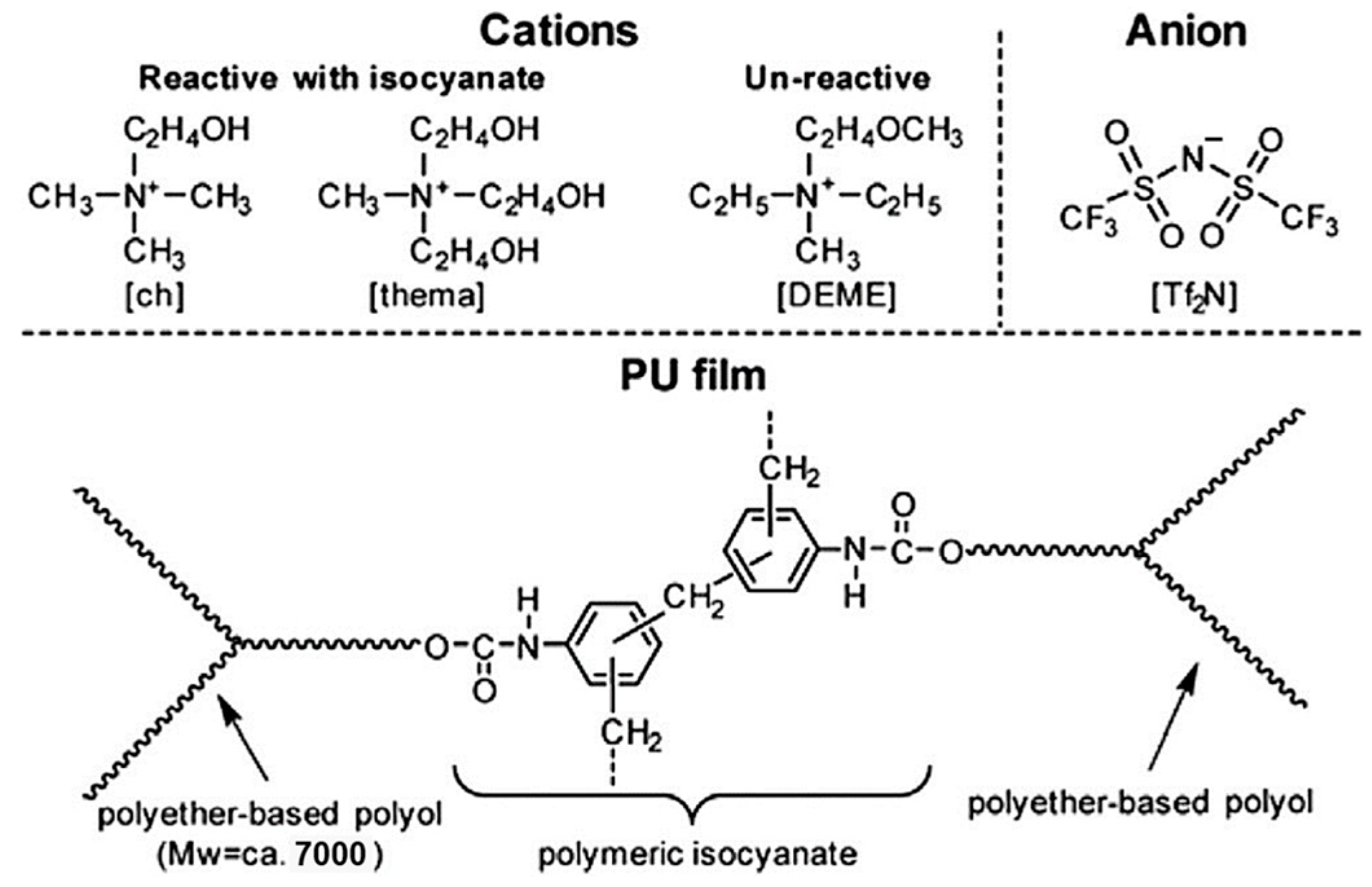

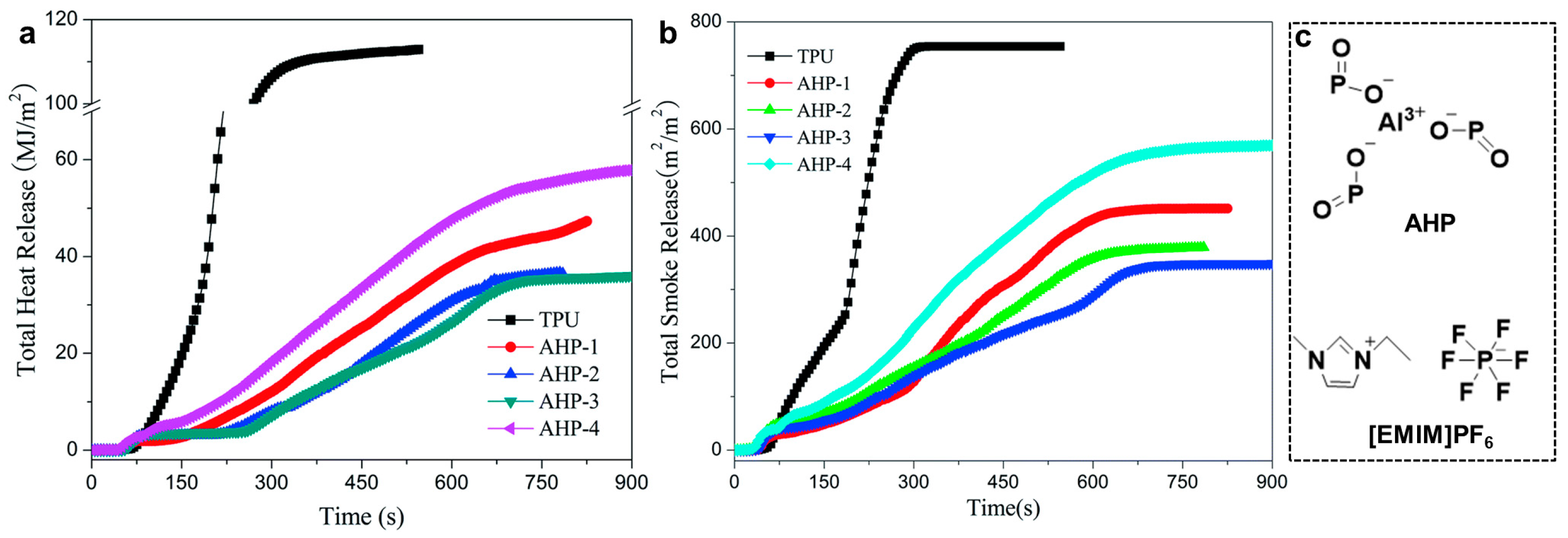
Disclaimer/Publisher’s Note: The statements, opinions and data contained in all publications are solely those of the individual author(s) and contributor(s) and not of MDPI and/or the editor(s). MDPI and/or the editor(s) disclaim responsibility for any injury to people or property resulting from any ideas, methods, instructions or products referred to in the content. |
© 2023 by the authors. Licensee MDPI, Basel, Switzerland. This article is an open access article distributed under the terms and conditions of the Creative Commons Attribution (CC BY) license (https://creativecommons.org/licenses/by/4.0/).
Share and Cite
Wang, X.; Zhao, Z.; Zhang, M.; Liang, Y.; Liu, Y. Polyurethanes Modified by Ionic Liquids and Their Applications. Int. J. Mol. Sci. 2023, 24, 11627. https://doi.org/10.3390/ijms241411627
Wang X, Zhao Z, Zhang M, Liang Y, Liu Y. Polyurethanes Modified by Ionic Liquids and Their Applications. International Journal of Molecular Sciences. 2023; 24(14):11627. https://doi.org/10.3390/ijms241411627
Chicago/Turabian StyleWang, Xue, Zhenjie Zhao, Meiyu Zhang, Yongri Liang, and Yingdan Liu. 2023. "Polyurethanes Modified by Ionic Liquids and Their Applications" International Journal of Molecular Sciences 24, no. 14: 11627. https://doi.org/10.3390/ijms241411627
APA StyleWang, X., Zhao, Z., Zhang, M., Liang, Y., & Liu, Y. (2023). Polyurethanes Modified by Ionic Liquids and Their Applications. International Journal of Molecular Sciences, 24(14), 11627. https://doi.org/10.3390/ijms241411627






